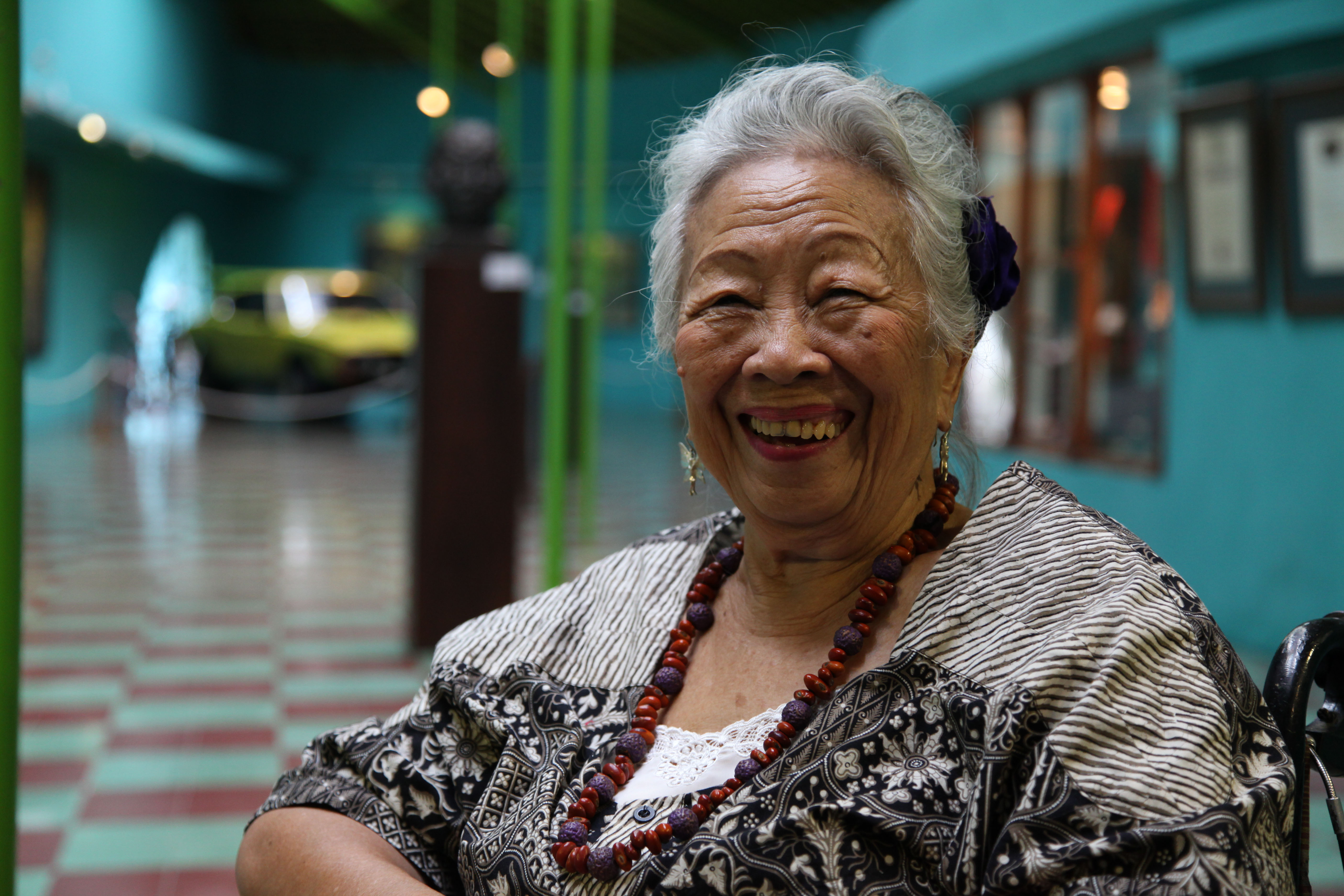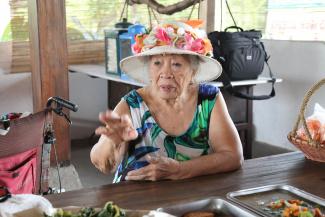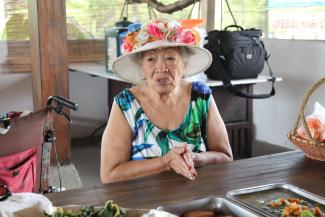Today I thought about posting a blog entry about the day I went with Kartika while she sketched and painted goats, or perhaps about the day we went to the school for the deaf in Yogya which she supports... or maybe about her father Affandi's art...or even about the 4-minute preview video "Kartika: The Life and Art of Kartika Affandi" I posted on YouTube yesterday at https://www.youtube.com/watch?v=0oogcumcAs0&feature=youtu.be (if you get a chance to watch it, please feel free to share it, and your comments on the page will be most welcome.)
I'll get to those blog entries later, but in a departure from the usual, today I have decided to post the text of this 2007 article about Kartika written by Cynthia Webb (to whom all rights remain). I really appreciate Cynthia's approach, her insight and warmth, as it shines through this piece. I will just add a few photos to it to give the page some colour. Thanks to Cynthia for allowing me to post the article here, and for her ongoing support of and input to the Kartika film documentary. Besides her work as a journalist Cynthia Webb is an artist herself, a former surfing champion, and an expert on cinema from Indonesia and the rest of the world - you can visit her cinema website at http://cynephilia.com/
Kartika Affandi: A Woman's Tough Journey
Cynthia Webb (First published in The Jakarta Post, 3 June 2007)
© Cynthia Webb, text reprinted with the author's permission
Recent celebrations in Yogyakarta marked 100 years since the birth of the Indonesian art icon, Affandi.
The beloved painter died in 1990, at 83. The inheritor of his talent and keeper of his legend is his 72-year-old daughter, Kartika, who started making portraits of him about five years before his passing.
She made a painting of Affandi on his deathbed, a few days before his demise, showing him lying on a green sofa wearing a desperate expression and gasping for breath.
Shortly before, he had been so weak he was unable to squeeze paint from the tube and was extremely frustrated by this.
Kartika explained, ""When I was a child we lived in poverty, often with only krupuk and kecap to eat, so my mother breastfed me until I was eleven.
I was often in trouble because I didn't come home till late, but went to friends' homes where there was more food.
My mother would hit me with a bamboo stick, but not too hard -- there was always a lot of love in our family and my father was wonderful, making toys and kites for me.
I had no younger siblings, and my father wished for more children and he even asked my opinion about his plan to take a second wife. I said that if he could fairly divide his love, then it was OK.""
Affandi is buried at the Museum site and his spirit is ever-present. ""The face of my father is still giving me the spirit to live,"" said Kartika, who has been painting a series of 100 portraits of him.
""I first learned to paint as a child, watching him and working with him. I began in 1957 with a brush, but this separation from the canvas by a tool didn't suit me, and I soon gave it up and worked straight from the tube and with my hands.
""I wanted to paint only for my own enjoyment, not take orders from other people. I painted what I could see around me. I opened a warung (food stall) in front of the house to earn money to feed my family"". She gave birth to eight children in 10 years.
Her first marriage to the painter Sapto, came to an end after 21 years, when he took not one but two other wives. This was too much for Kartika and she attempted suicide.
She was told by her lawyers that she was the first woman in Indonesia to go to the High Court to seek a divorce. She was told that it was impossible for an Islamic woman to divorce her husband, but she wouldn't take no for an answer, and eventually succeeded in gaining her freedom.
""I wanted to find my own creative style because my work was looking a lot like my father's. So I asked him how I could develop myself and he gave me US$2,000 so that I could go to Paris.
""I saw an exhibition of black-and-white works, which were very strong, and I discovered that working in black-and-white made me feel very happy. My art and my life were being simplified.
""However, the reality was that I needed to sell my work and art collectors didn't understand. They told me that black-and-white work was considered a sketch, and a painting must be in color, so I was forced to go back to color,"" Kartika reminisced.
However, the colored works have a distinctly illustrative quality, like drawing.
Kartika's work is visceral, immediate, and more than a little wild, like the woman herself. Her response to the world has no time for any interruptions or refinements of technique. It goes straight to canvas uncensored, and its brilliance lies in its spontaneity and truth.
Kartika's life journey has spanned great social change in her country, and in her personal life.
Into her hands came the inheritance of the Affandi Museum and with it the responsibility of carrying on the memory, and caring for the art works at the same time as raising her children and pursuing her own powerful artistic identity.
She realised, mid-life, that it was necessary to study art conservation, so in 1980 Kartika set off to study at the Vienna Academy of Fine Art.
She felt great liberation studying with much younger companions, and it was as if she had been reborn.
She made a painting, Re-Birth, in 1981, showing herself, a nude woman giving birth to an adult child whose face has already experienced a lot of life -- herself.
She fell in love again, with her Austrian Yoga and Meditation Teacher, Gerhard Koberl. ""Everything was sweet again"" smiled Kartika.
The change was visible in the colors in her works, which altered to softer, even pastel tones. She returned to Indonesia on visits with her works, and showed them to her father, who said, ""Kartika, you don't have to pursue me anymore. You are an artist now.""
Gerhard and Kartika returned to marry and live in Java; however, the relationship ended when in 1994 he, too, left Kartika for a younger woman.
He divided their land with a fence and lived next door with his new wife -- a difficult thing for a woman to bear. In 2000 Kartika found herself in the divorce court again.
She was concerned about this, because she has numerous female grandchildren and didn't want them thinking that their grandmother was a bad woman: It just turned out that way, guided by the actions of her men, not herself.
During the last years of her marriage to Gerhard the colors in works became very pale, in contrast to her formerly riotous palette.
She said it represented the sapping of her spiritual strength at the time. Now she has found serenity and says that she doesn't want to marry again although she has a man in her life. Kartika, though, is not just ""the daughter of Affandi"". She is a powerful artist in her own right.
She has been a trail-blazing Indonesian woman, breaking down cultural barriers, living her life her own way, traveling widely, sometimes defying convention, while fulfilling her family duties at the same time.
""I always try to be a good person. I have studied Buddhism for 25 years, and in my heart I am a Buddhist although we also celebrate Islamic and Catholic festivals at home.""
Like Frida Kahlo in Mexico, Kartika painted a visual diary of her own life -- the pleasure and the pain -- and as she turned the pages of her 2004 book "Kartika: Looking back through Life" and told her story, I felt a strong sisterhood for her and the common experience of women everywhere.
She is an inspiration, both as an artist and as a woman.
In the last two years Kartika has become a little bored with painting and taken up sculpture. She has made some large works, one of which can be seen in the Museum reception area.
She has made some mischievous phallic forms with amusing heads and expressions on their faces, shown in resting and waiting positions.
Kartika said, ""I had the urge to shock people, and to make men think differently about woman.""
She explained that she didn't want to make the lingam erect as this might appear ""dirty"", and that is not her intention. The mood is humourous and affectionate, and there is no negative feeling towards the male or his member.
Her latest project, already begun, is the creation of a Women's Art Museum, located at Pakem on the lower slopes of Mount Merapi.
Kartika stated, ""The responsibility of the Affandi Museum is a joy for me, not a burden. We've been working for three years with family, friends and staff on this Centenary Celebration.
""I sold 20 of my own paintings very cheaply to pay for this. My daughter Helfi is now the director of the museum, and I am a VIP guest,"" said Kartika.
She is pleased to see the dedication to Affandi's memory passed down the generations so that the future of the museum will be assured.


